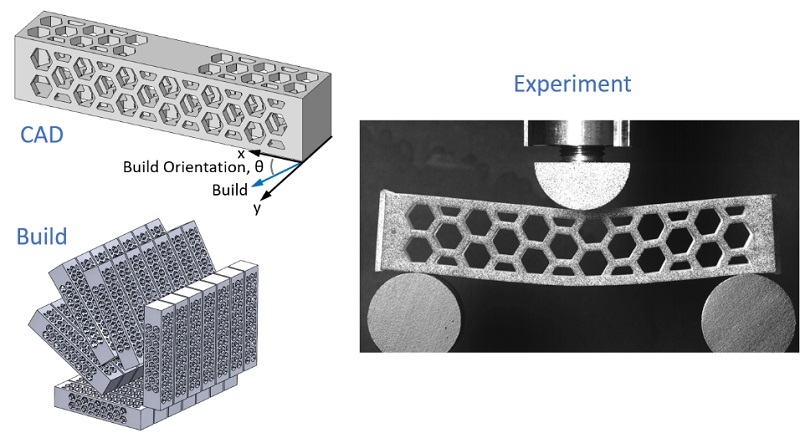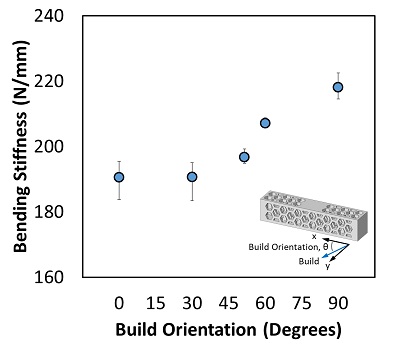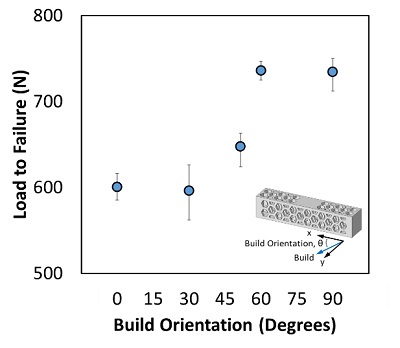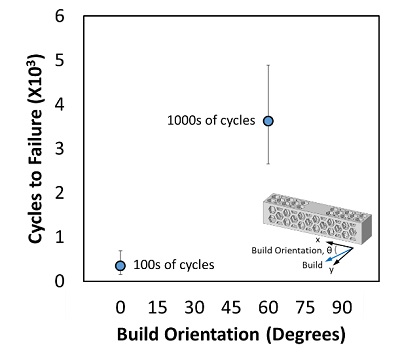Technical Challenge
Additive manufacturing (AM) enables the production of complex lattice structures that cannot feasibly or economically be manufactured any other way. Lattices and other periodic structures can be used to manufacture parts with reduced mass, tailored stiffness profiles, and improved energy-absorbing characteristics.
However, there are two complicating factors that engineers are likely to confront when designing fine AM lattice structures: geometric inaccuracy and anisotropic material properties. AM processes build parts in discrete layers of ~20-100 µm thickness. Thus, the actual cross-sections of lattice struts can vary as the geometric features of lattice structures get smaller. Additionally, the mechanical properties—particularly the yield and failure properties—of AM materials can be highly anisotropic. Both of these factors can make a part’s structural behavior strongly dependent on build orientation.
Of course, the sensitivity of a structure to build orientation will depend upon the material, processing, surface, and loading details. Regardless of these differences, engineers must understand and account for any build orientation effects. Failure to do so can result in unacceptable variation in part performance or unexpected mechanical failure.
Veryst Solution
To understand better the dependence of lattice mechanical behavior on build orientation, Veryst used the lattice structure shown in Figure 1. The struts measured 2 mm, or 20 build layers, wide. We printed the part in polyamide 12 using selective laser sintering at different orientations. We then measured how build orientation influenced the stiffness, strength, and low-cycle fatigue life in three-point bending.
Stiffness
Elastic stiffness is the most basic mechanical property of a structure. Ideally, the bending stiffness of an AM lattice would be independent of the build orientation. However, this isn't necessarily the case as Figure 2 demonstrates. The bending stiffness of our test structure varied from 190 N/mm to 220 N/mm. Again, all the parts were printed in the same build. We measured the mechanical properties of the material using tensile bars and found the elastic modulus to be effectively isotropic with a value of 1.9 GPa. Thus, the observed 15% variation is primarily due to variation in the produced geometry of the part.
Strength
The bending strength of the parts also varied significantly with build orientation, ranging from 600 N to 735 N (see Figure 3). We attribute this behavior to a combination of both geometric error and material anisotropy. The ultimate strength of the material varied from 48 MPa to 56 MPa, measured using tensile bars. The details of how part strength varies with build orientation is important when trying to optimize the conflicting requirements of maximizing both mechanical performance and part packing. Our structure exhibited effectively constant strength between a build orientation of 60° and 90° but dropped off significantly at build orientations below 60°.
Fatigue Life
A difference in strength of 20% may seem modest, but it can have a drastic impact on fatigue life, as shown in Figure 4. We tested parts built at orientations of 0° and 60° under cyclic loading (50 N to 500 N at 0.5 Hz) to compare the low-cycle fatigue life. The peak force of 500 N is about 83% of the ultimate strength for the 0° part but only about 68% of the ultimate strength of the 60° part. As a result, the parts with a build orientation of 0° had a fatigue life of a few hundred cycles. The parts with a build orientation of 60° could survive a few thousand cycles. The exact same parts built at the exact same time have an order of magnitude variation in fatigue life due to a difference in build orientation.
Conclusion
The stiffness, strength, and fatigue life of additively manufactured lattice structures can depend significantly on build orientation. Regardless of the AM process being used, engineers must develop an understanding of these effects through careful experimental testing on well-designed specimens, to ensure consistent part performance and reliability.
More information on additive manufacturing activity at Veryst Engineering can be found here.



